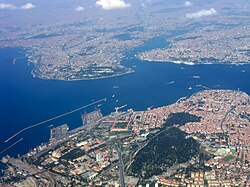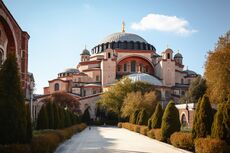Leonople
This article is incomplete because it is pending further input from participants, or it is a work-in-progress by one author. Please comment on this article's talk page to share your input, comments and questions. Note: To contribute to this article, you may need to seek help from the author(s) of this page. |
Leonople | |
|---|---|
City | |
| Νέα Αλbα Λεōνοúπολισ | |
 | |
|
Official seal of Leonople Coat of Arms | |
| Nickname: Γέφῡρᾰ τοῦ κόσμου (Bridge of the World) | |
| Country | |
| Theme | Polin (coterminous) |
| Established | 887 BCE |
| Founded by | Perseus |
| Government | |
| • Body | City Assembly |
| • Eparch | Georgios Zonaras |
| Population | |
| • Rank | 1st |
| • Urban | 6,115,437 |
| Time zone | UTC+3 (EBT) |
| Patron Saints | Saint Leo |
Leonople (Perateian: Λεονοπολισ), officially Nea Alba Leonopolis (Νέα Αλbα Λεōνοúπολισ), is the largest city and capital of the Perateia. Leonople is a transcontinental city, straddling the Perseid Strait that separates Scipia and Ochran's [peninsula]. The city is coterminous with the theme of Leonople. The city holds a strategic place between the Periclean Sea and the Ozeros Sea.
Founded as Peration or Perateia by ancient Linhidosi Gythacan colonists in the 9th century BCE, it was renamed Leonople in 331 BC by Leo the Great. Leonople served as capital of Leo's empire, and became a major center of Helianic civilization. Leonople subsequently grew in size and prominence due to a confluence of trade routes between not only Scipia and Ochran, but Belisaria through the Periclean and Ozeros connection. The city served as provincial capital in the ancient Latin Diocese of the East. It then became the capital of the Peratene Empire from 5th century onward, of which it remains today.
The city played a major role in the spread of Sarpeticism, and specifically Christianity throughout the eastern Periclean and the Ozeros Seas, and hosted at least 5 widely recognized ecumenical councils. It remains a major center of trade and hub of culture due to its linking position btween the Periclean and Ozeros Seas. The city has a population of 6,115,437, comprising of 51% of the population of Perateia, and is one of the most populous cities in Scipia.
Etymology
Settlements in this area have had many different names since its founding. The first recorded settlement was referred to as Perseon. This name stems from the ancient mythological figure of the same name, Perseus, who is the legendary founder of the city and a demi-god claimed to be the leader of ancient Helianic colonists entering the area.
The city was known as Perseon from its founding in the 9th century BC until 331 BC when it was re-founded by Leo the Great and renamed Leonople, or "City of Leo". This remains the most widely accepted name for the city today. Due to Leonople's role in Perateian history, it is frequently referred to as The City by its inhabitants and Perateians.
Geography
Leonople is separated by the Perseid Strait, which connects the Periclean and Ozeros Seas. Old Leonople rests at a promontory commonly known as the Getaberan. It is a natural estuary that connects with the Perseid Strait where the strait meets the Periclean Sea. The confluence of the Getaberan, Periclean Sea and Perseid Strait is at the heart of Leonople.
The Getaberan, and more ancient districts of Leonople rest on the Scipian side of the straits, with modern expansion and developments placed on the Ochran side. Semistra Hill is the highest point in Leonople at 800 feet.
Climate
Leonople is characterized by Periclean climate and some oceanic climates due to its location. Its coastal regions are predominantly Periclean, while the northern areas of the city near Semistra feature characteristics of oceanic climates. Closer to the Getaberan, the climate is more drier and less humid. In northern areas, fog is more common most mornings, specifically in the fall and winter. Rainfall is uncommon in the summer, though historically features the most severe thunderstorms.
Administration
The Eparch and City Assembly are responsible for the government and administration of city-theme.
The Eparch is the chief representative of the city and is charged with presiding over the Assembly, akin to that of a mayor. He manages the city's executive administration and providing direction for policies. The current Eparch is Georgios Zonaras.
The City Assembly is the legislative arm of the city government. It consists of 50 members elected to four-year terms. Its powers included fiscal matters, approval of budgets, and services management.
Myrelaion Palace has served as the seat of city government since 1836.
Demographics
Since its re-founding in 341, Leonople has been one of the largest cities in the eastern Periclean region. As of 2020, its populations is estimated around 6.1 million residents, with nearly 67% on the Scipian side of the city. The city experienced its most rapid population growth between 1970 and 2000. The area around the Getaberan is the most densely populated area of the city.
Religious and ethnic groups
Leonople has featured a diverse population since its founding due to its strategic geographic location, though has been largely Lihnidosized for much of its history. The largest ethnic group in Leonople consists of Perateians, at approximately 76% of the urban population. The largest single minority group in Leonople is Lerazgan. TBD are also among the largest minority groups in the city, making up nearly 6% of the population. The TBD population is near even split between the three major christian faiths located in the city, along with a small TBD Azdarin community located near Semistra. Latins compose a growing population within the city, today standing near 3% of the population. Other prominent minority groups include Gheiravins and Kards.


